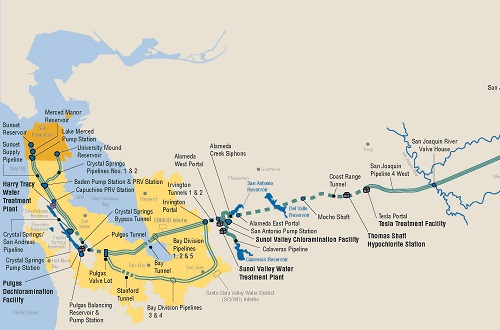Water System
We own and operate the Hetch Hetchy Regional Water System which serves 2.7 million residents and thousands of businesses. We provide water directly to residents and businesses San in Francisco and wholesale customers through 27 cities and public water agencies in Alameda, Santa Clara, and San Mateo counties.
The San Francisco Public Utilities Commission and water agencies across the state are involved in on-going negotiations with the State on a voluntary agreement for implementation of the San Joaquin-Sacramento River, Bay-Delta Water Quality Control Plan (Bay-Delta Plan), which calls for large increases in water releases on the tributaries to the San Joaquin River, a major tributary to the Bay-Delta.
The adopted Bay-Delta Plan addresses water quality issues affecting the ecosystem and fisheries of the Bay-Delta system. That includes the Tuolumne River, which provides water via Hetch Hetchy Reservoir to Bay Area customers. The SFPUC has voiced concerns with the Plan, as it would dramatically reduce the agency’s water supply, leaving our millions of Bay Area customers subject to significant rationing in droughts and more extreme weather conditions brought on by climate change. The SFPUC has also raised concerns over the fishery benefits of the State’s Plan.
In response to the Bay-Delta Plan, the SFPUC and the Modesto and Turlock Irrigation Districts proposed the Tuolumne River Voluntary Agreement, a combination of flow and non-flow measures sufficient to improve all life-stages of native fish populations in the lower Tuolumne River. The Tuolumne River Voluntary Agreement is now part of the multi-agency Agreement to Support Healthy Rivers and Landscapes, a voluntary agreement addressing concerns from Sacramento and San Joaquin river water agencies. The SFPUC has consistently stated that voluntary agreements are the best path forward for the Bay-Delta, as the voluntary agreement strikes the right balance between environmental stewardship and water reliability.
While the long-term voluntary agreement work continues, the SFPUC and our partners on the Tuolumne River do not want to wait to restore the Tuolumne River’s ecosystem. In 2021, the SFPUC and the Modesto and Turlock Irrigation Districts launched a proactive pilot program with the U.S. Fish and Wildlife Service that provides an immediate $4 million investment for habitat improvements for fisheries in the Tuolumne River.
Upcountry and the Bay Area
The upcountry portion of the System begins with Hetch Hetchy Reservoir in Yosemite National Park. Impounded by O’Shaughnessy Dam, Hetch Hetchy Reservoir water passes through hydroelectric powerhouses before it enters the San Joaquin Pipelines, the Tesla Ultraviolet Treatment Facility, and the Coast Range Tunnel on its journey to the Bay Area.

The Bay Area portion of the System includes water collection, treatment, and transmission facilities from the Alameda East Portal to the wholesale service area and terminal reservoirs in San Francisco. Water storage facilities include watersheds, dams, and reservoirs including: Calaveras, San Antonio, Crystal Springs, Pilarcitos, and San Andreas. The water treatment facilities are Tesla Ultraviolet Treatment Facility, disinfecting the Hetch Hetchy supply; Sunol Valley Water Treatment Plant, treating the water from the Calaveras and San Antonio supply as well as the stored Hetch Hetchy supply; and Harry Tracy Water Treatment Plant, treating the water from the Crystal Springs and San Andreas supply. The water transmission system in the Bay Area and Peninsula includes the Bay Division, San Andreas, Sunset Supply, and Crystal Springs pipelines. The Bay Area transmission system also includes Irvington Tunnel 1 and Tunnel 2, the Bay Tunnel, and the Crystal Springs Bypass Tunnel.
San Francisco Supply
Within San Francisco, we manage water distribution in the City. This system encompasses more than 1,250 miles of distribution pipelines, as well as 12 in-City reservoirs and eight water tanks with a total storage capacity of approximately 413 million gallons. Since June 2011, the Water Enterprise has operated the City’s Emergency Firefighting Water System (EFWS, formerly known as the Auxiliary Water Supply System (AWSS)), an independent, high-pressure water supply system for fire suppression.
Our drinking water comes from a variety of protected sources carefully managed by the SFPUC. These sources include surface water stored in reservoirs located in the Sierra Nevada, Alameda County and San Mateo County, and groundwater supplies stored in a deep aquifer located in San Francisco and San Mateo counties. These sources are diverse in both the origin of the supply – snowmelt, rainfall and recharge of groundwater – and their location within our system. Maintaining this variety of sources is an important component of our near and long-term water supply management strategy. A diverse mix of sources protects us from potential disruptions due to emergencies or natural disasters, provides resiliency during periods of drought, and helps us ensure a long-term, sustainable water supply as we address issues such as climate uncertainty, regulatory changes and population growth.

